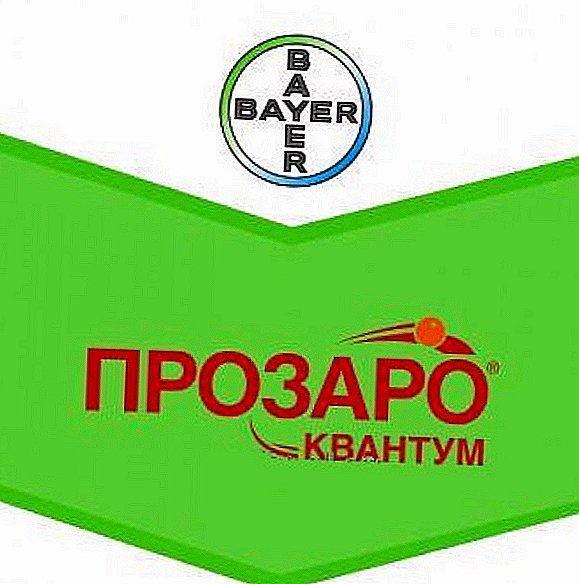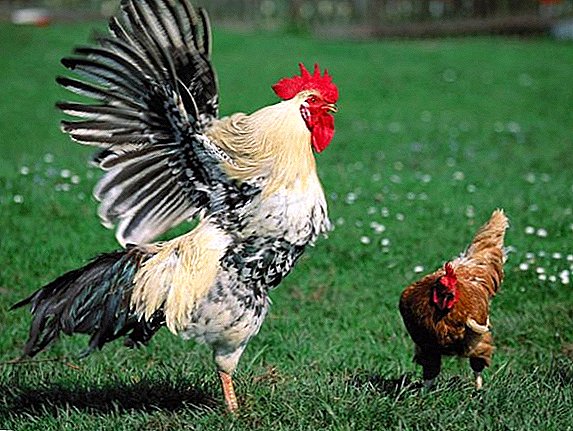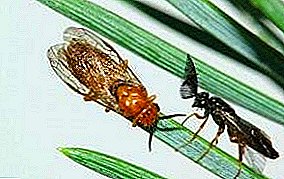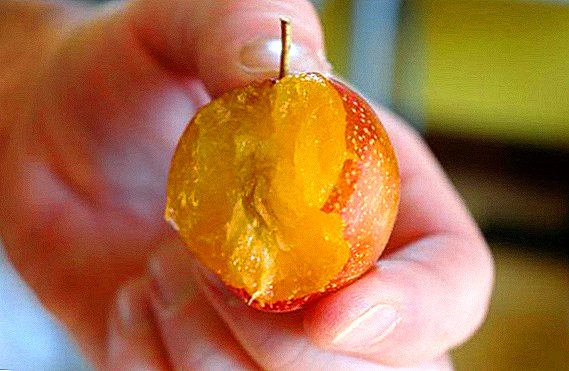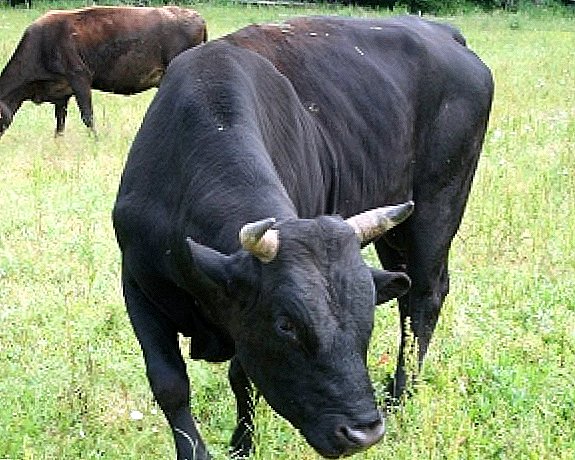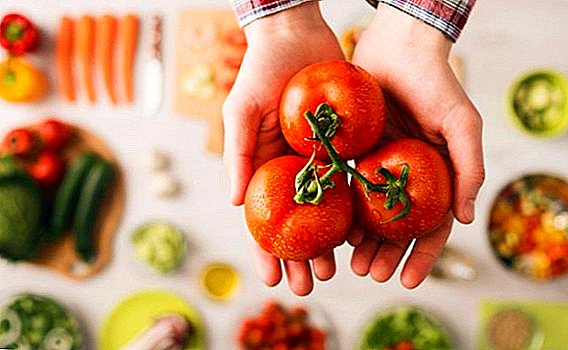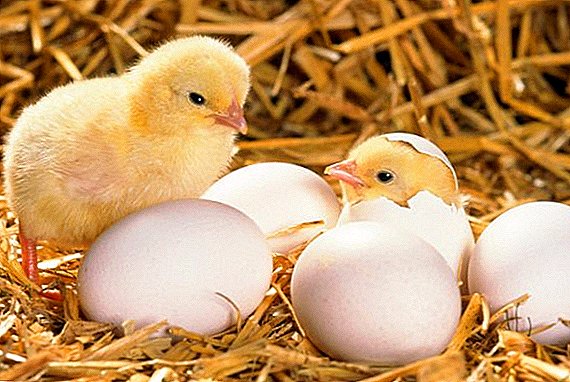 Many novice poultry farmers are wondering about whether it is possible at home to bring broiler chickens.
Many novice poultry farmers are wondering about whether it is possible at home to bring broiler chickens.
And the answer here will be ambiguous, since in this case one should strictly adhere to the recommendations below, while having the equipment necessary for the process.
So, let's understand the specifics of this procedure for the points.
What is the difference in incubation of broiler eggs from the rest
Broiler cross is a chicken breed, resulting from the mating of individuals of two directions (father - meat purpose, and mother - egg).  The conclusion of such a hybrid at home is quite a complicated procedure, a prerequisite for the successful result of which is the presence in the household of both breeds for further crossing.
The conclusion of such a hybrid at home is quite a complicated procedure, a prerequisite for the successful result of which is the presence in the household of both breeds for further crossing.
Chicken breeds include such breeds as Ross-708, Ross-308, Cobb-700, Hubbard, Arbor Icres.
The difference between broiler eggs and simple chickens is that the first ones are larger.
Nevertheless, the incubation period in this case remains the same as that of ordinary chickens - 21 days, in contrast to the warm-up period of broiler-like duck eggs and turkey eggs (28 days), as well as the largest - goose (31 days) .
The period of pre-incubation storage of chicken and turkey eggs is no more than 5-6 days, duck reproductions - 7-10 days, and goose - 15 days.  Incubation, or hatching of chicken offspring, is a specific procedure for embryo formation and further development of the chick under heat exposure, during which his body feeds on the yolk and also saturates its cells with oxygen entering through the pores of the egg shell.
Incubation, or hatching of chicken offspring, is a specific procedure for embryo formation and further development of the chick under heat exposure, during which his body feeds on the yolk and also saturates its cells with oxygen entering through the pores of the egg shell.
During the development of the embryo, carbon dioxide, water and heat are released from the bird's product, while the latter is released in about 10-15 days.
In this regard, after 15 days of incubation, overheating of eggs can occur, which is why it is necessary to warm up the products before this period is reached, and then to remove heat and increase the ventilation of the incubator.
Did you know? The main hierarchical step in the social structure of the chicken society is occupied by the rooster: it is he who controls the morning awakening population the chicken coop, the time they eat, go to sleep, also regulates conflicts in the chicken herd, while protecting them from attacks by outside predators.
In contrast to the incubation of chicken eggs, in the case of broilers, the duration of ventilation should be increased by 3 times. 
How to choose eggs for incubation
The selection of broiler eggs for the purpose of breeding chickens should be approached very responsibly, since not all specimens are suitable for use in these purposes. The same dimensional and volume characteristics is one of the conditions for the success of the results.
Learn more about how to choose high-quality eggs for incubation, as well as how to wash eggs before laying in the incubator.
It should be borne in mind that the most optimal are not small and not large specimens, but medium ones, weighing about 50-60 g. In the first case, the embryos may be weak and not capable of full development, in the second the eggs may not be fertilized at all, so how is the probability of having more than one yolk.
Also requires the same preliminary shelf life of samples selected for incubation.
Important! Unnecessary grams in the total mass of eggs prolong the process of hatching, and the large interval in time between the appearance of chicks in the light is not a favorable factor for their nurturing.
A pear-shaped, too elongated or rounded shape of eggs indicates their fruitlessness, or unsuitability for incubation. The uniform surface of the shell should exclude any kind of cracks, growths, thickening or roughness. 
Pre-bookmark actions
The chicken fertilized testicle forms for 20 hours after insemination of the yolk with rooster sperm: as it passes through the egg canal, it is enveloped in several layers of protein, and the shell gland that is in the body of the hen provides the shell layer.
Before laying eggs in the apparatus they need to be checked for fertilization: for this purpose it is best to use an ovoscopic lamp.
Evidence of successful results of the formation of the embryo will be the presence of such factors as:
- the presence in the center of the yolk of a dark, clearly limited speck;
- equal from all sides of the egg shell density;
- a clear air chamber visibility, its small size (not more than 1.5 cm) and the location between the inner and outer shell membranes near the blunt end of the product (otherwise the eggs are old and not subject to the incubation process);
- blurred lines of yolk placed in the center or in some approximation to the blunt end of the sample;
- the slow turning of the yolk during the rotation of the product, which indicates the integrity of the structure of the egg;
- the absence of any blackouts, including blood clots, worms eggs, or the second yolk in the product.
 Freshness of the samples is determined by the color characteristics and saturation of the yolk: too dark color and its exact borders are a prerequisite for marriage.
Freshness of the samples is determined by the color characteristics and saturation of the yolk: too dark color and its exact borders are a prerequisite for marriage.In no case is it allowed to penetrate to the incubated egg white reproductive products, since it acts on them destructively by blocking the holes through which the embryo exchanges oxygen with the outside world.
In order to avoid the above effects, eggs should be pretreated with a warm (+ 30 ° C) manganese solution of a saturated raspberry color. It is necessary to immerse the products in this fluid for 5 minutes, very carefully, so that the contents do not shake.
The cleaned samples are also neatly laid out on the fabric matter to complete natural drying, then they can be laid out in the incubator.  The maximum shelf life of eggs before incubation is 6 days, with each day of overexposure the hatchability rate of chickens is significantly reduced, starting from 7 days and 15%.
The maximum shelf life of eggs before incubation is 6 days, with each day of overexposure the hatchability rate of chickens is significantly reduced, starting from 7 days and 15%.
Apart from the fact that the day before the egg is laid, eggs should be stored at room conditions, it is also necessary to warm each of them at a temperature of + 22 ° C for 5-6 hours.
Important! If you do not have the opportunity to purchase an ovoscope, for the first time a self-made home appliance is suitable. To do this, you will need a cardboard box, at the bottom of which a 60 W electric lighting device is installed. In its upper wall, you need to cut a small hole the size of a little less than the eggs that you took on the tab.
Bookmark
In poultry farming, it is customary to apply two methods of laying eggs into an incubator apparatus:
- First of these - a method of synchronous bookmarking of reproducts, in which all the testicles, without exception, are placed in the device simultaneously, after which the desired mode is established. Thus, hatchery hatching takes place evenly or with very small deviations in the time frame.
- Second wayIt is also called universal, which differs by the fact that after the first laying of eggs every 3-7 days, one more product is added to the artificial bird-removing device. Those testicles, whose duration in the incubator reaches 15 days, begin to release heat independently, while warming the other eggs that were added later.
 The correct location of the broiler eggs in the incubator is horizontal or slightly oblique at an angle of 45 degrees with a small distance between them. A large volume of reproducts provides for an initial enhanced heating, gradually decreasing in the future.
The correct location of the broiler eggs in the incubator is horizontal or slightly oblique at an angle of 45 degrees with a small distance between them. A large volume of reproducts provides for an initial enhanced heating, gradually decreasing in the future.In our article we will consider the way in which instances for incubation are laid simultaneously. At the same time, the bottom surface of the device must be completely filled in order to evenly warm the testicles: their insufficient number threatens with hypothermia, and the surplus - overheating.
Familiarize yourself with the features of growing in an incubator chickens, ducklings, guinea fowls, turkey poults, goslings, quails, indoutok.
Temperature incubation of eggs
One of the prerequisites for a successful incubation result is the constant monitoring of the thermal conditions in the apparatus, the indicators of which differ depending on the period of reproduction in the incubator.
This affects the metabolic rate of the embryo, and accordingly, the rate of its development. In the initial days (1-4 days), the temperature norm is the highest: from +37.9 to 38 ° С. It is imperative to avoid sudden changes in temperature.  From 5 to 8 days the temperature should be gradually reduced by 0.3 °, that is, to + 37.7 ° C, and from 9 to 14 days - by another 0.2 ° (to + 37.5 ° C).
From 5 to 8 days the temperature should be gradually reduced by 0.3 °, that is, to + 37.7 ° C, and from 9 to 14 days - by another 0.2 ° (to + 37.5 ° C).
The 15 day rule was previously indicated: we remove the source of heat from the eggs, gradually reducing the thermal performance to + 37.3 ° C. Already towards the end of the incubation, the temperature in the apparatus should be at + 36.8 ° C. 21 days as the final stage of the incubation period provides for the thermal regime in the range of + 36.4-36.2 ° C.
How to turn and spray eggs
The reversal of the reproducts is carried out so that the body of the embryo does not stick to the membrane membranes, as well as the body systems of the future chicken to fully develop, receiving new nutrients.
In this regard, experienced poultry farmers have long used incubation preparations equipped with a mechanical turning function.
In the case when you perform the above actions yourself, systematicity is important.  It is necessary to turn over all products without exception simultaneously at certain intervals of time (ideally, several times a day in the first week, in the second number of turns can be reduced).
It is necessary to turn over all products without exception simultaneously at certain intervals of time (ideally, several times a day in the first week, in the second number of turns can be reduced).
The period during which it is necessary to turn the eggs, is counted from the start of incubation to 15-18 days. This process contributes to the timely removal of thermal excess from the sample surface, as well as the supply of oxygen to the embryo in a normal amount.
Spraying is performed only in the case of a low degree of humidity in the incubator, only with warm water to avoid hypothermia.
Incubation Humidity
Humidity standards during the incubation process are no less significant than maintaining a certain temperature. Humidity of reproducts directly affects the porosity of their shells. 
For the success of breeding healthy and full chicks, experts recommend sticking to the following tips:
- the first 10 days, the degree of moisture should be at the level of 50-55%;
- then it is necessary to reduce this level to 45%;
- the next 15-18 days, the level of moisture content of air should be increased to 65%. This will make it easier for chickens to peel the shells.
When eggs are hatching and chicks hatching, the humidity is regulated by the newborn itself, so it is no longer necessary to monitor its increase.
Newbies in the poultry industry often face the problem of establishing a reliable indicator of egg moisture without a hygrometer designed specifically for this device. 
In order to determine the humidity, it is necessary to do the following:
- make sure that the electric incubator is in working condition and executes the specified commands for maintaining the previously set temperature;
- Take two thermometers, one of which is wrapped with cotton or cotton cloth folded 2-3 times;
- then wet the wrapped part of the thermometer in pre-boiled and defended clean water, remove the excess liquid - this will give you a so-called moisturized thermometer, and the second, accordingly, will be referred to as dry;
- after turning off the incubator, put both devices to measure the temperature in the device at a short distance from each other, but placing them on the same level. Close the machine cover;
- connect the device to the network and wait about 15 minutes;
- open the lid of the device, take both thermometers (at the same time the cloth on the wet should not dry out completely) and check your data with the following psychrometric table.
| Temperature dry thermometer ° C | The temperature of the wet thermometer ° C | |||||||||
| 25 | 26 | 27 | 28 | 29 | 30 | 31 | 32 | 33 | 34 | |
| Humidity,% | ||||||||||
| 36 | 38 | 43 | 48 | 53 | 58 | 63 | 68 | 74 | 79 | 86 |
| 36,5 | 37 | 41 | 46 | 51 | 56 | 61 | 66 | 71 | 76 | 83 |
| 37 | 35 | 40 | 44 | 49 | 54 | 58 | 63 | 68 | 74 | 83 |
| 37,5 | 34 | 38 | 42 | 47 | 52 | 56 | 61 | 66 | 71 | 77 |
| 38 | 32 | 36 | 41 | 45 | 50 | 54 | 59 | 64 | 68 | 74 |
| 38,5 | 31 | 35 | 39 | 43 | 48 | 52 | 57 | 61 | 66 | 71 |

What is dangerous high or low humidity
Maintaining a certain humidity regime is mandatory. For example, an increase in the moisture level in an incubator can cause a distortion of the normal shape of the paws of chicks; in addition, under such conditions it will be very difficult for progeny to rearrange themselves for pulmonary respiration.
And, on the contrary, low moisture provokes the emergence of dehydration phenomena in embryos, which prevent the growth and hatching of chicks.
It is also possible to monitor the correctness of the incubation procedure and the well-being of the embryos by daily weighing of the products for some time. The corresponding rate of egg shrinkage is from 0.5 to 0.7%.
If significant weight loss is detected, it is necessary to lower the temperature and increase the moisture content of the air. Conversely, if, as a result of the control weighing, you find small shrinkage, it is worthwhile to resume heating the products with simultaneous ventilation of the eggs and a decrease in air moisture.  If the steam conductivity of the shell is at a good level, then by 18 days the eggs will lose up to 12% moisture.
If the steam conductivity of the shell is at a good level, then by 18 days the eggs will lose up to 12% moisture.
Proper ventilation during incubation
Already after the first week of incubation, it is necessary to proceed to airing the container. This procedure cools the testicles by the entry of air from the room in which the incubator is located.
Before the curse itself, eggs have an increased level of heat transfer, therefore, to avoid overheating, the incubator should be ventilated twice a day for at least half an hour. In the case of too large egg laying (more than 150 pieces at a time) the flow of air into the apparatus should be constant.
Incubation stages
Incubation, like any complex process, is divided into separate stages preceded by certain circumstances: the formation of an embryo, as well as the establishment of the validity of egg fertilization. 
- Laying broiler eggs in an incubation apparatus, the establishment of the required indicators of temperature and humidity for the resumption of germ growth, as well as the division of embryonic cells in the germinal disc.
- In the first two days of incubation the future chicken starts to form a head with eyeballs, the circulatory and nervous systems, and also the heart muscle.
- During 3-4 days of incubation warming up of the product, the heart works fully.as well as the formation of auxiliary membranes and amniotic film designed to protect the embryo during the entire incubation period.
- Over the next 5 days, the formation of the legs and wings ends, there are first signs of a chicken's natural cover - feathers, and also a bone system is formed in the form of a small skeleton of a future chick. In order to see all these changes, it is necessary to do repeated ovoscopy on the 6th day of incubation, and if nothing has changed in the internal structure of some of them since the day of laying eggs, then they should be thrown away. It is necessary to ensure that the body of the embryo does not stick to one of the walls of the shell, and also that the blood system is well developed.
- Fifth stage It lasts from 10 to 21 days, during which the legs and wings of the chick are gradually covered with muscle tissue, and the beak, scaly covering of the legs and claws are formed from the cornified matter. The next routine ovoscopic examination should be carried out on the 11th day of incubation: normally, all of the eggs should be filled with blood strings, and there should not be any less meaningful or empty places in the dull or sharp lobes of the egg. Starting from the 16th day, a partial, and in the period before the nesting of chicks, the maximum ventilation of the incubation apparatus is performed. From 19 days the chick is extremely necessary to maximize the flow of oxygen into the blood, which causes the baby to break through the membrane pocket to the air chamber located at the blunt end of the egg. The beak of the chick opens for the first time because of this, and the further supply of blood with air affects its full circulation.
- Sixth stage - the period between the first attempts to curse the shell until the baby is born. In the last days of incubation, an additional container with water should be placed in the apparatus in order to prevent drying of the insulated layers under the influence of dry air. Расположение яиц при этом меняется: теперь они кладутся на бок с учётом дистанции между ними и больше не переворачиваются. За день перед их появлением на свет можно услышать, как птенчики издают первые звуки, делая начальные проклёвывания в скорлупной оболочке с целью захватить дополнительный воздух в лёгкие.Under natural circumstances, the chicks receive a response and a “call to the will” from their mother hen: this is why it is good to purchase an incubator with built-in playback of sounds like natural ones.
- Closing stage - hatching a broiler chick, which is a big stress for a chicken: it sees the world for the first time, but it is drained and wet. It is not recommended to turn off the incubation device during this temporary period, since after the first appearance of the light, the following can go immediately. And in order to dry and warm, the kids should stay in the incubator for another 1-2 days, after which they are resettled in a specially designated place. As food for this time, the newborn has a yolk, which at the time of hatching must be completely absorbed into the gastrointestinal tract of the chicken, but the presence of the remaining yolk mass under the belly of the nestling in most cases ends in a hernia and death.

Common mistakes and tips for newbies
Before you perform all the necessary actions in the process of incubating broiler eggs, you should carefully read all the nuances and subtleties that may arise later in order to avoid possible misses.
Did you know? Representatives of domestic birds have the same affection for people, like dogs or cats. Scientific studies show that at the first manifestations of attention from the owners to newborn chickens, the latter increase their motivation, they rather adapt to the world around them, become stronger and stronger. In addition, they are able to memorize their faces.
Among the most common mistakes made by amateur poultry farmers are the following:
- Incorrect placement of the thermometer, for example, if it is installed near the vent hole, it will show false information: due to the air flow, the temperature on the thermometer will be displayed less than what it actually is, therefore, raising them can cause overheating of reproducts;
- different temperature characteristics in different parts of the container apparatus: in order to avoid this, experts recommend regularly replacing the testicles;
- increased or decreased air moisture content;
- A frequent factor in frequent mortality among chickens is underheating of eggs: in this case, they hatch later and are born underdeveloped (with a not prolonged navel, full legs, sluggishness, and lack of physical activity and movement).
 Thus, after reading this article, we can conclude that the incubation method of breeding the offspring of a home broiler is a rather laborious, time consuming and responsible process.
Thus, after reading this article, we can conclude that the incubation method of breeding the offspring of a home broiler is a rather laborious, time consuming and responsible process.Did you know? Chickens are the most common species of birds on earth: according to recent estimates, their number is 19 billion. In the spring-summer period of each year, more than a dozen people on the planet are necessarily engaged in both natural hatching and hatching.
And, nevertheless, having studied all the above recommendations, as well as gaining patience and showing diligence, even a beginner will be able to cope with this task.



